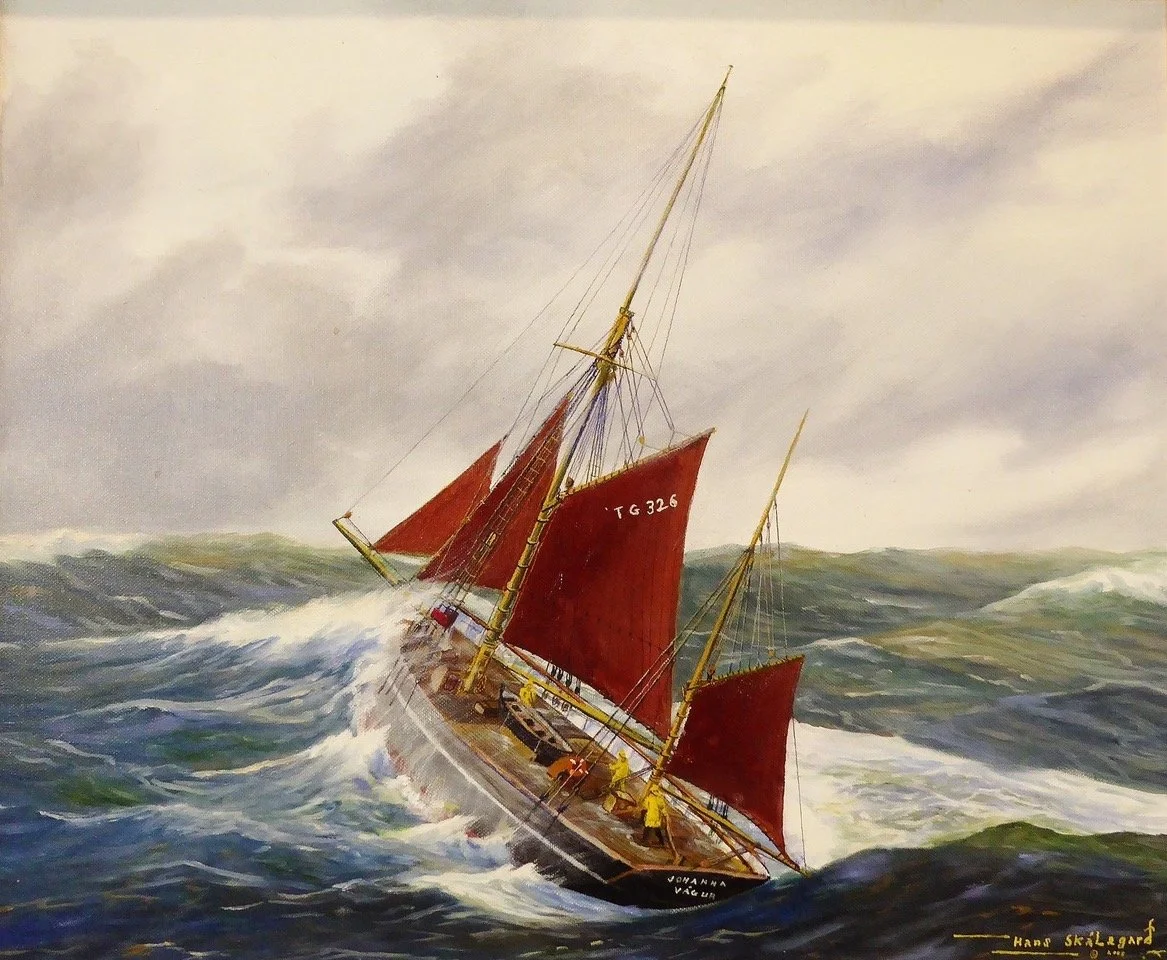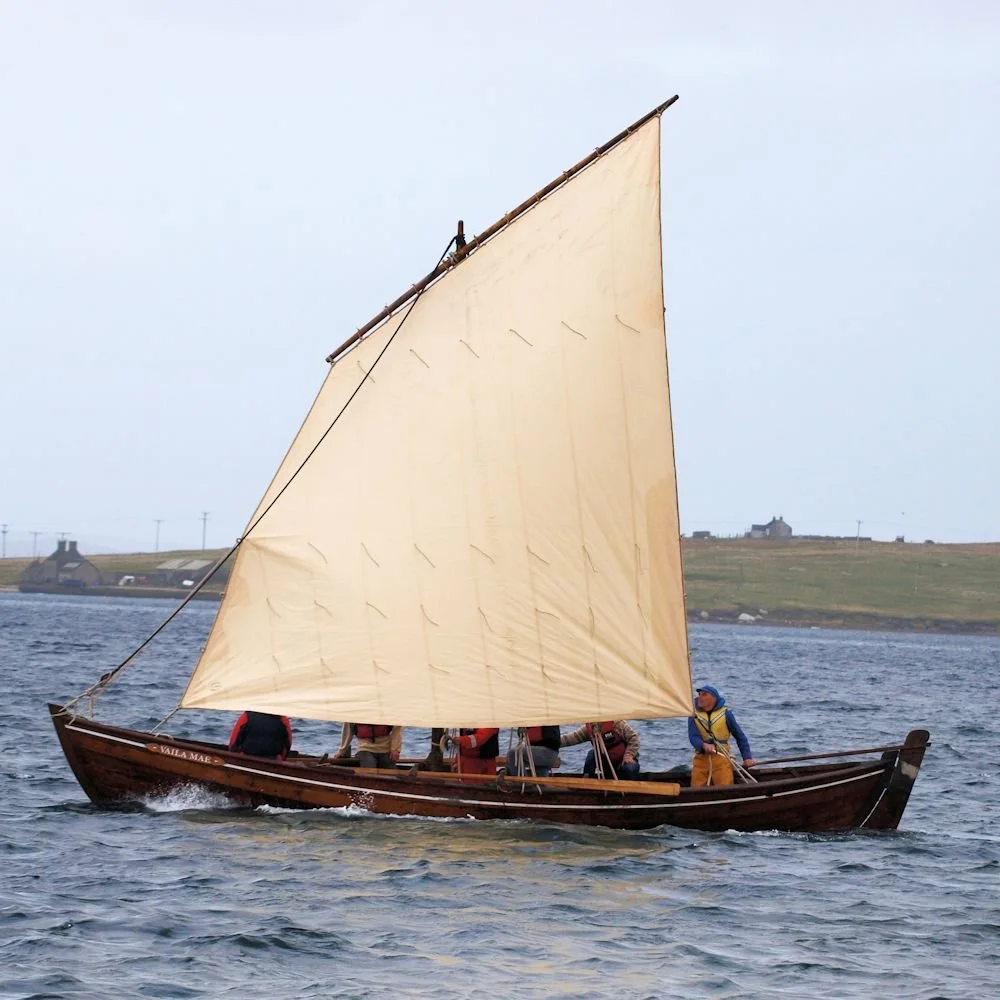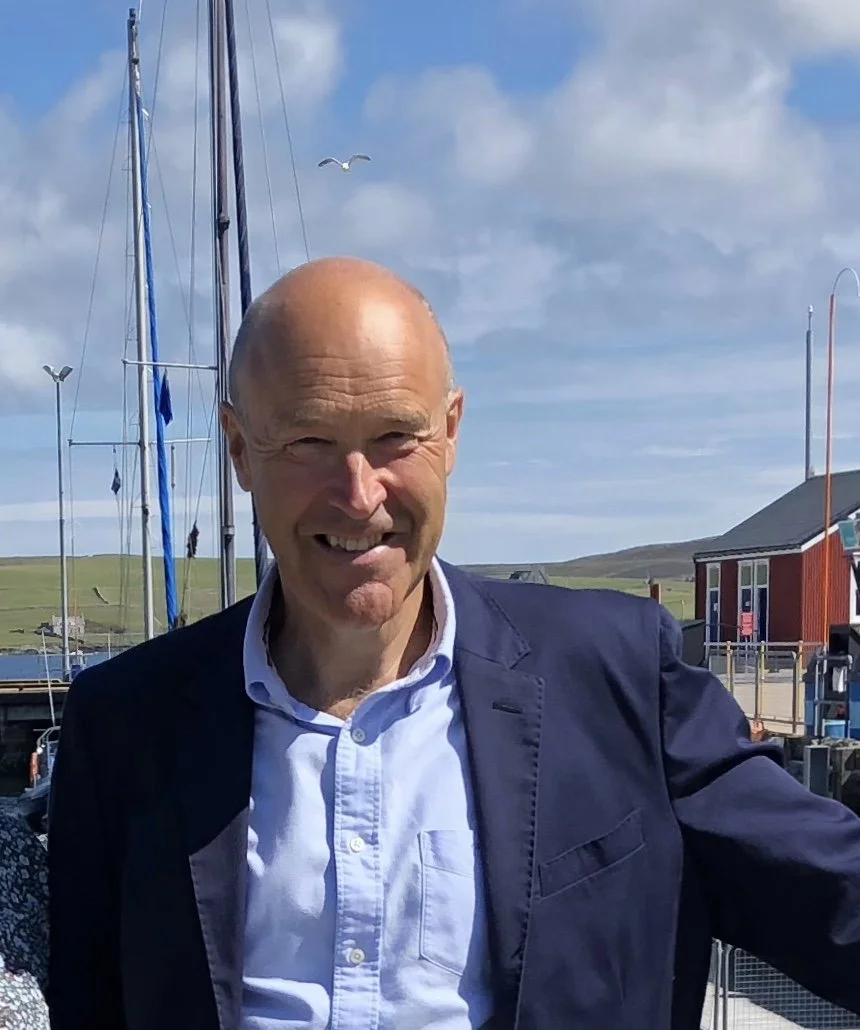Excerpts from ‘The Salt Roads’
Faroe Brandy
John Goodlad
A Cod Smack
A few years ago I sailed from Shetland to Faroe on board the Swan – a restored herring smack. After a rough crossing we were blessed with good weather in Faroe. On our way back ,we decided to take the Swan in past Suðuroy, the most southerly of the Faroese islands. After a few hours sailing we tied up in the attractive harbour of Tvøroyri. With a population of around 1,500, it is still a prosperous place, although not as important as it was in the 19th century when it was one of the main fishing ports in Faroe.
Later that day, a few of us went for a stroll through the village. As we walked, we began to talk about the first Shetlanders who came to Faroe to fish. We wondered if some of these cod fishermen, maybe even some of our own ancestors, had walked these same streets more than a hundred years before. Making our way back to the boat, we saw the rest of the crew sitting inside a bar, called Pubbin, in what had once been the Thomsen merchant store, one of the old cod companies in the village. As we joined them, I noticed that our skipper, Magnie Sinclair, was not there. Someone explained that he had stayed on board to hear the latest shipping forecast. Looking around the pub, I could see that there was an eclectic collection of all kinds of things on the shelves and on tables. I realised that all of this – the glass jars, the old tobacco tins, the brandy pigs and the fishing gear – had once been for sale. This is not a pub trying to look old. This is a merchant store that now sells alcohol and food and has not seen any need to clear away the evidence of its previous life.
When we had settled down to enjoy our beer, the lady behind the bar came across to ask if we were from Shetland. Dressed in faded Levi’s and a baggy Faroese jumper, she introduced herself with a welcoming smile as Anna Kirstin Thomsen, the owner of Pubbin. Short and slim, with cropped auburn hair, she was both energetic and enthusiastic. She told us that she had been brought up with stories of the Shetland fishermen who used to fish around Faroe. Many of them were regular visitors to Tvøroyri and they were well known to her family when they ran their merchant business. She told us there were company records that showed which Shetlanders had come into their shop and what they had bought. ‘It was mostly brandy and tobacco,’ she added with an impish grin.
I asked if these records were stored in the archives in Tórshavn or Copenhagen. She just laughed and asked me to follow her next door. We went into a room that had once been an office and there, lying on an old table, were company ledgers detailing all the transactions that took place. Although the entries were all in Danish it was easy to read which Shetlanders had bought what, when and at what price. Just as I was starting to look through the ledgers, I overheard Magnie shout in the door that he had just heard that a gale was forecast for tomorrow, and we would be best to leave now. So, having just discovered this treasure trove of information about the Shetland cod fishermen, I had to leave them unread. It would be four years before I came back. I barely had time to finish my beer.
When I eventually found my way back to Tvøroyri and began to read the ledgers, I was astonished. The scale of the purchases was staggering. Many Shetlanders regularly purchased huge quantities of brandy and tobacco. In 1863 John Williamson of the Petrel bought brandy to the value of over £17, while Ross Georgeson of the Caroline spent more than £21. At this time, the average annual wage for a cod fisherman was around £18. Other purchases were more modest, ranging from £3 to £10 in value, mostly for brandy but also tobacco and occasionally items of clothing.
One entry that caught my eye was in April 1864, when William Goodlad bought brandy and three woollen jumpers for the comparatively small sum of £1.65. He was one of my ancestors and was aged 19 at the time. He was drowned eight years later when his smack, the Turquoise, was lost on her way back from Faroe.
As I sat at the old desk examining these precious ledgers, I noticed the dust particles in the atmosphere were sparkling in a shaft of bright sunlight that had suddenly found its way through the shuttered window. As this short glimpse of sun disappeared, I became aware of how beautiful the copper-plate ink handwriting was. No one writes like this anymore; it was entirely legible but much more than utilitarian. The graceful lines and bold capitals spoke of a confident merchant, recording his daily business in a manner that was pleasing to the eye. Looking around at the worn wooden floor and the faded paint on the pine lined walls, it occurred to me that little had changed in this room since Anna Kirstin’s ancestors had sold brandy to mine.
Philadephia
John Goodlad
A Sixern
In July 1832 an unprecedented and severe five-day summer storm caught the Shetland sixern fleet at sea. These small open boats were entirely unsuited to such conditions, and many were lost. A total of 117 fishermen lost their lives that week.
One of the sixerns that had been thought lost with all hands was from the I island of Whalsay. Today this island is home to one of the most modern fishing fleets in Europe, but in the early 19th century it was just one of many poor Shetland communities trying to eke a living from the sea. Tammy Hughson and his crew – including his two sons, Willie and Lowrie – were tired by the time they had rowed to the fishing grounds and shot their lines. Remarking about the abnormal calm that surrounded them, the skipper was concerned about how warm it was. He felt uneasy; it was never calm and warm like this when you were 30 miles east of Shetland in a boat.
With the sudden onset of the storm at midnight, the crew immediately knew what had to be done: four men hauled on oars to keep their head to wind
while the other two furiously bailed. It was hard work, with no time to rest or eat. Within minutes every man was soaked through. Hour by hour this continued, as Tuesday morning became Tuesday evening. A combination of sheer terror and a determination to hang onto life fuelled a superhuman effort
to keep their boat afloat. But eventually the fuel runs out. By Wednesday morning serious exhaustion had set in and the crew had reached the point of giving up and allowing the sixern to run before the storm, in the certain knowledge that she would broach, fill with water and sink. It was then that they saw a large sailing barque in the distance.
This was the Edwards, a Danish ship on her way to America with emigrants on board. Summoning their last reserves of energy, Hughson’s crew rowed towards the barque. The captain of the Edwards had seen them, and he was able to steer his ship into the wind, allowing the Whalsay boat to come close behind her lee quarter. A rope was made fast to hold her in position while a Jacob’s ladder* was thrown over the side. The seas were so mountainous that one minute the sixern was level with the deck of the Edwards, and the next it was down at her keel. It was almost impossible to get hold of, let alone climb up, the Jacob’s ladder. Ropes were then lowered to haul the crew on
board the barque one by one. For some reason one of the crew, Davie Henderson, failed to properly secure the rope to himself. Whether he thought he still had the strength to hold on or, as was more likely, his mind had become addled through exposure and fatigue, he lost his grip and fell to his death into the raging seas.
Once on board, the crew were carried below decks where they were revived with dry clothes, food and brandy. Tammy Hughson asked if there was any chance that they could be put ashore in Lerwick. The captain explained that it would take him several days tacking into the storm to reach Lerwick and he was therefore going to maintain his course to pass between Orkney and Shetland on his way to Philadelphia.
By the time they had arrived in America the Shetlanders had fully recovered and were anxious to get back home as soon as they could. But that was not going to be easy; they had no money, and their only possessions were the clothes they were wearing. A Quaker church managed to secure some accommodation and work for them while they waited to see if the British Consul could get them home. Eventually securing a passage on a ship bound for Liverpool, they arrived in late December. After making their way to Leith, they boarded the George Canning, which was scheduled to arrive in Lerwick on Christmas morning, which in Shetland fell on Saturday 5 January. Arriving safely in Lerwick harbour that morning, there was incredulity that this crew,
thought lost in the July gale, had survived. Anxious to return to their families, they tried to arrange a lift with a Lerwick sixern. This was not easy as it was Christmas morning and permission had to be sought from the Church before they could leave.
That same morning on Whalsay, the skipper’s old dog, which had pined for her master for the past six months, had become restless and agitated when let out of the barn by the skipper’s widow, Charlotte Kay. She had lost her husband and two sons in the gale and was struggling to make a living from their small croft for her seven remaining children. Although there was talk
of a relief fund, she had not yet received a penny. The dog set off running to the south, away from the Hughson croft. Charlotte sent two of the younger boys to fetch her back, thinking she had more than enough to cope with on that bleak Christmas morning without an unruly dog. After a long chase over rough ground the two Hughson brothers eventually caught up with the dog. She was running back and forth on a beach, barking at a sixern that was slowly approaching. A small crowd had gathered, having already seen the boat in the distance. No one could think of any good reason why a sixern would have been sailing to Whalsay on Christmas morning.
And then the impossible happened. The entire island had spent six months grieving for the crew and now here they were stepping ashore. Disbelief and shock must have been only two of the emotions experienced by everyone on the beach. These were men who they believed had drowned last July. As word went around the island, and as each man was reunited with his family, there was unbridled joy that was only tempered when Davie Henderson’s widow, Merran Shearer, arrived to ask how her husband had met his end.
A few weeks after they had arrived back home, Charlotte received a letter with a Philadelphia postmark. It was from Tammy, explaining they were alive and would try to make their way home as soon as they could.
John Goodlad
John is a Shetlander who has worked in the seafood industry throughout his career. For many years he represented the fishers of the Shetland Islands. He then became a fish farmer, specialising in the production of organic salmon and halibut. More recently he has worked for Prince Charles’s International Sustainability Unit, providing advice and leadership on a variety of global fisheries and aquaculture initiatives. He continues to advise several international organisations on issues of seafood sustainability.
John has written three books and is currently working on his fourth.
His first book, The Cod Hunters, was published in 2018. Telling the story of the Shetlanders that fished for cod around Faroe in the nineteenth century, this book was short listed for the Maritime Foundation best book
The Salt Roads looks at how the trade in salt fish linked Shetland to Europe for more than 300 years and inspired many artists, writers and musicians during that time. Published in 2022, this book has been translated into Dutch and Faroese and is now also available as an audio book.
Food from the Sea – The Future of Seafood was published in June 2025. Looking at the many challenges facing the contemporary seafood industry this book is written through the lived experiences of fishers and fish farmers around the world.


